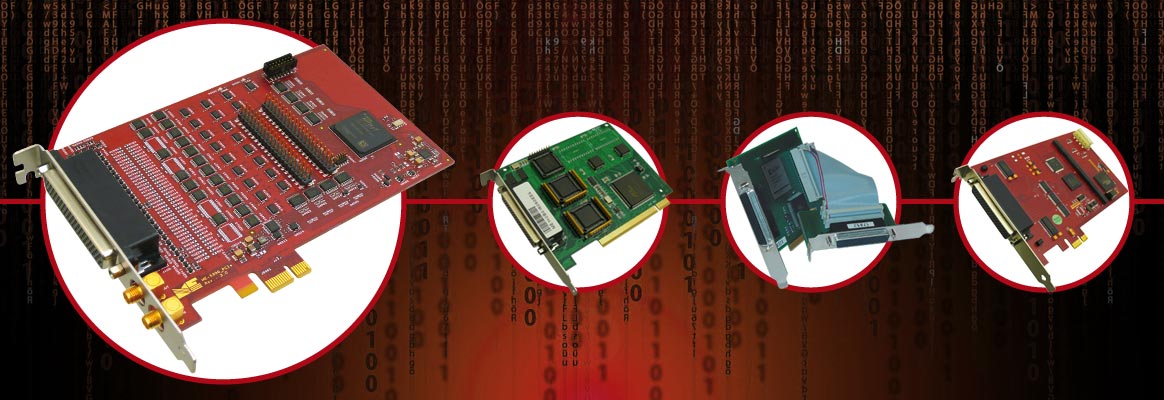ME-5300 - the New Generation of TTL-Digital-I/O

Benefits of the Meilhaus Electronic ME-5300 Digital Interface Board Series
- Two proven, reliable board families in a new design!
- Up to 128 TTL digital channels.
- Up to 15x 16 bit counters.
ME-5300 - the New Generation of TTL Digital-I/O
The ME-5300 is a TTL digital I/O board series. It replaces several models of previous ME board families ME-1000, ME-1400, and ME-5100. A modernized, improved architecture with the latest FPGA is used as well as the current bus platforms PCI-Express (PCIe). The cards are fully compatible with the previous models in terms of connector pin assignment, functionality and software. Depending on the corresponding firmware, the ME-5300 transforms into the following models:
Model Overview
| Model | TTL digital-I/O | Counters | Bus platform | Replaces | Pull-up | Pull-down |
| ▸ME 5310-Series | ||||||
| ME-5310 | 4x 32 bit ports: 128 digital-I/O lines, 64 of them on 78-pin D-sub female, other 64 on an on-board pinfield |
- | PCIe | ME-1000/641) | - | - |
| ME-5310 + ME-1001 | Connects the on-board 64 digital-I/O lines from the pinfield to an additional 78-pin D-sub female with slot bracket | - | PCIe | ME-1000/128-2) | - | - |
| ▸ME-5314 Series | ||||||
| ME-5314A | 24 | 3, 16 bit | PCIe | ME-1400A1) | Gate | DIO, Clk |
| ME-5314B | 48 | 6, 16 bit | PCIe | ME-1400B1) | Gate | DIO, Clk |
| ME-5314C | 24 | 15, 16 bit | PCIe | ME-1400C1) | Clk, Gate | DIO |
- As a standard, the pullup/pulldown resistors are configured so that the boards are compatilbe with the previous versions.
- The ME-5310 can be expanded to up to 128 digital channels using the ME-1001. Using the ME-5310 as the base board you get full compatibility with the ME-1000/128.
Frequently asked questions:
Question: What are TTL digital I/O channels used for?
Answer: Digital channels are used to output/write or input/read binary/logic signals. In the simplest case the signal level is TTL/CMOS - the signals are led directly (e.g. without galvanic isolation by optocouplers) from the components to the connector. Binary/logic signal means that these signals take only two logical states 0/1, Low/High, for example 0 V/5 V.
Question: What is a port?
Answer: For digital I/O boards, a port is the group of a certain number of digital lines (8 bit port, 16 bit port, e.g. as a bit pattern). In contrast to opto-isolated channels, where the opto-couplers define the signal direction, TTL channels are mostly bidirectional lines, which can be configured as inputs or outputs. In many DAQ boards/modules this configuration is done port-wise, i.e. an entire port group of e.g. 8 channels is used as input. One of the best known digital components for this kind of I/O (PIO - Parallel Input Ouput) is the Intel 8255, which works with the port concept. In contrast to this, with discrete lines, all individual channels can be configured individually for themselves as input or output.
Question: What is a counter used for?
Answer: A counter/timer is a classic digital component (e.g. Intel 8253, 82C54). Programmable counters/timers usually offer different modes of operation. A standard mode is e.g. counting down from the start value (65535 at 16 bit) to 0, timer interrupt and counting again. The counter component receives a clock as basis (e.g. independent from the clock of the PC from a quartz oscillator). Optimally all counter signals are available at the connector (clock, gate/enable/disable counting, out), so that cascading or using an external clock is possible.
Question: What is included with the Meilhaus Electronic measuring cards?
Answer: The scope of delivery of each card includes a mating connector, so that individual connection cables can be soldered with simple means (e.g. if a card has a 78-pin D-sub female connector, a 78-pin D-sub male connector is included). Of course, ready-to-use, optional accessories are available for most standard cases, such as connector cables and terminal blocks/boards. The driver software ▸ME-iDS (incl. Control-Center, SDK and ▸ME-PowerLab3) as well as detailed manuals (English and German) for the DAQ board and the software are available via download.
Last seen
































